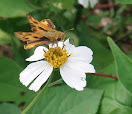I don't usually copy other blog articles but this one touches an area that I am quite passionate about- native landscaping to create suburban wildlife habitats. Read on...
From Cool Green Science Blog
Get Native, Backyard Birders!
By Dave Mehlman
The February 2009 issue of Conservation Biology has a research paper on the impacts of native plants on birds and butterflies in the suburbs of southeastern Pennsylvania.
To my knowledge, this is the first scientific study to compare “standard” landscaping (lawns, ornamental trees and shrubs) with “native” landscaping (using grasses and other groundcovers, shrubs and trees that naturally occur in the area).
Since one of my interests is in the use of native plants for yard landscaping and in how to make yards more attractive for birds, this paper immediately caught my eye!
The research team from the University of Delaware found very significant differences between otherwise similar properties that differed in their landscaping. Properties with native landscaping had significantly more species of birds and more individual birds that those with standard landscaping.
Similarly, there were more species of conservation concern (including Wood Thrush, Scarlet Tanager, and Eastern Towhee), and they were more abundant in properties with native landscaping. The authors suspect that what’s going on is that the more diverse native landscapes attract more numbers and kinds of insects, which in turn serve as food for the birds.
This conclusion is supported by the finding that there were significantly more kinds and numbers of insect-eating birds at properties with native landscapes than standard landscapes, while the kinds and numbers of birds that eat everything (omnivores) was the same between the two kinds of sites.
While we clearly need to have this kind of work replicated in more geographic areas, this suggests great benefits to landscaping with native plants, at least in the eastern United States. So all of us with yards can contribute to the work of bird conservation (and enjoy some really cool plants at the same time!).
There is quite a lot of information available on how to improve your yard for birds and other wildlife. A good place to start is the Certified Wildlife Habitat program of the National Wildlife Federation. And it’s never too early to start!
Subscribe to:
Post Comments (Atom)

No comments:
Post a Comment
Please keep comments on subject- Thanks!